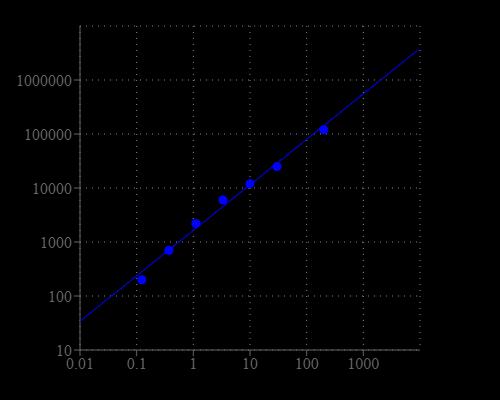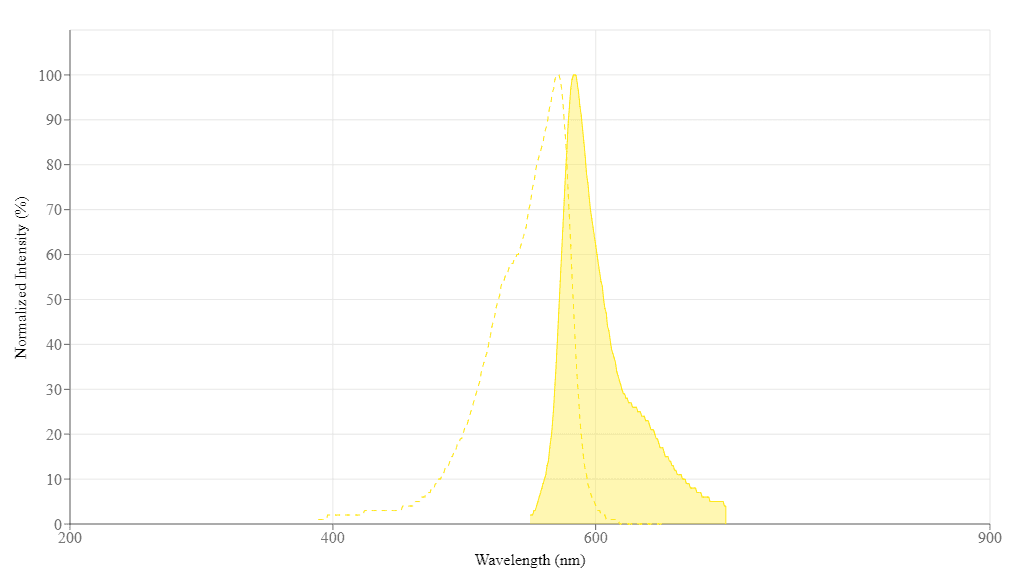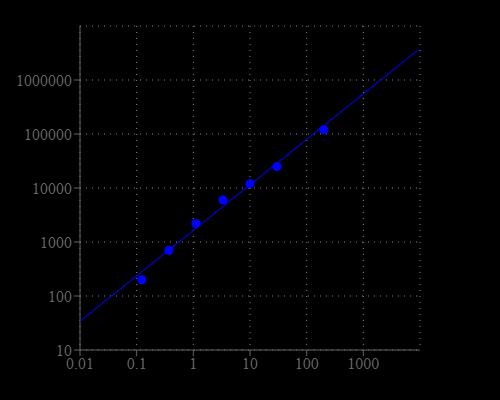Amplite® Fluorimetric Acetylcholine Assay Kit *Red Fluorescence*
Ordering information
| Price | |
| Catalog Number | |
| Unit Size | |
| Quantity |
Additional ordering information
| Telephone | 1-800-990-8053 |
| Fax | 1-800-609-2943 |
| sales@aatbio.com | |
| International | See distributors |
| Bulk request | Inquire |
| Custom size | Inquire |
| Shipping | Standard overnight for United States, inquire for international |
Spectral properties
| Excitation (nm) | 571 |
| Emission (nm) | 584 |
Storage, safety and handling
| H-phrase | H303, H313, H333 |
| Hazard symbol | XN |
| Intended use | Research Use Only (RUO) |
| R-phrase | R20, R21, R22 |
| UNSPSC | 12171501 |
| Overview |
Excitation (nm) 571 | Emission (nm) 584 |
Acetylcholine and its metabolites are needed for three main physiological purposes: structural integrity and signaling roles for cell membranes, cholinergic neurotransmission (acetylcholine synthesis), and as a major source for methyl groups via its metabolite, trimethylglycine (betaine) that participates in the S-adenosylmethionine synthesis pathways. It plays an important role in the central nervous system as a precursor for acetylcholine and membrane phosphatidylcholine. This Amplite® Fluorimetric Acetylcholine Assay Kit provides one of the most sensitive methods for the quantifying acetylcholine. The kit uses Amplite® Red™ to quantify acetylcholine through choline oxidase-mediated enzyme coupling reactions. The fluorescence intensity of Amplite® Red™ is proportional to acetylcholine.
Platform
Fluorescence microplate reader
| Excitation | 540 nm |
| Emission | 590 nm |
| Cutoff | 570 nm |
| Recommended plate | Solid black |
Components
Example protocol
AT A GLANCE
Protocol Summary
- Prepare ACh standards or ACh test samples (50 µL)
- Add ACh working solution (50 µL)
- Incubate at room temperature for 10 - 30 minutes
- Monitor fluorescence intensity at Ex/Em = 540/590 nm (Cutoff = 570 nm)
CELL PREPARATION
For guidelines on cell sample preparation, please visit https://www.aatbio.com/resources/guides/cell-sample-preparation.html
PREPARATION OF STOCK SOLUTIONS
Unless otherwise noted, all unused stock solutions should be divided into single-use aliquots and stored at -20 °C after preparation. Avoid repeated freeze-thaw cycles.
1. Amplite™ Red stock solution (250X)
Add 40 µL of DMSO (Component E) into the vial of Amplite Red™ (Component A) to make 250X Amplite™ Red stock solution.2. Acetylcholine standard solution (50 mM)
Add 200 µL of ddH2O into the vial of Acetylcholine Standard (Component C) to make 50 mM Acetylcholine standard solution.PREPARATION OF STANDARD SOLUTION
For convenience, use the Serial Dilution Planner:
https://www.aatbio.com/tools/serial-dilution/11403
https://www.aatbio.com/tools/serial-dilution/11403
Acetylcholine standard
Add 20 µL of 50 mM Acetylcholine standard solution to 980 µL Assay Buffer (Component D) to generate 1000 µM Acetylcholine standard solution. Take 1000 µM Acetylcholine standard and perform 1:10 in Assay Buffer (Component D) to get 100 µM Acetylcholine standard (AS7). Take 100 µM Acetylcholine standard (AS7) and 1:3 serial dilutions to get serially dilited of acetylcholine standard (AS6 - AS1) with Assay Buffer (Component D). Note: Diluted Acetylcholine standard solution is unstable, and should be used within 4 hours.PREPARATION OF WORKING SOLUTION
- Add 5 mL of Assay Buffer (Component D) to the bottle of Acetylcholine Probe(Component B) and mix well.
- Add 20 μL of 250X Amplite Red™ stock solution into the bottle of AcetylcholineProbe solution to make Acetylcholine (ACh) working solution.
Note This Acetylcholine (ACh) working solution should be used promptly andkept from light. The assay background would increase with longer storage time.
SAMPLE EXPERIMENTAL PROTOCOL
Table 1. Layout of Acetylcholine standards and test samples in a solid black 96-well microplate. AS= Acetylcholine Standards (AS1 - AS7, 0.14 to 100 µM); BL=Blank Control; TS=Test Samples.
Table 2. Reagent composition for each well.
| BL | BL | TS | TS |
| AS1 | AS1 | ... | ... |
| AS2 | AS2 | ... | ... |
| AS3 | AS3 | ||
| AS4 | AS4 | ||
| AS5 | AS5 | ||
| AS6 | AS6 | ||
| AS7 | AS7 |
| Well | Volume | Reagent |
| AS1 - AS7 | 50 µL | Serial Dilutions (0.14 to 100 µM) |
| BL | 50 µL | Assay Buffer |
| TS | 50 µL | test sample |
- Prepare Acetylcholine standards (AS), blank controls (BL), and test samples (TS) according to the layout provided in Tables 1 and 2. For a 384-well plate, use 25 µL of reagent per well instead of 50 µL.
Note Treat cells or tissue samples as desired. - Add 50 µL of Acetylcholine (ACh) working solution to each well of Acetylcholine standard, blank control, and test samples to make the total Acetylcholine assay volume of 100 µL/well. For a 384-well plate, add 25 µL of Acetylcholine (ACh) working solution into each well instead, for a total volume of 50 µL/well.
- Incubate the reaction at room temperature for 10 to 30 minutes, protected from light.
- Monitor the fluorescence increase with a fluorescence microplate reader at Ex/Em = 540/590 nm (Cutoff = 570 nm).
Images
Citations
View all 35 citations: Citation Explorer
Adlay hull extracts attenuate $\beta$-amyloid-induced neurotoxicity and oxidative stress in PC12 cells through antioxidative, anti-inflammatory, and antiapoptotic activities
Authors: Tsay, Gregory J and Lin, Yu-Ta and Hsu, Chia-Hong and Tang, Feng-Yao and Kuo, Yueh-Hsiung and Chao, Che-Yi
Journal: Biochemistry and Biophysics Reports (2021): 101020
Authors: Tsay, Gregory J and Lin, Yu-Ta and Hsu, Chia-Hong and Tang, Feng-Yao and Kuo, Yueh-Hsiung and Chao, Che-Yi
Journal: Biochemistry and Biophysics Reports (2021): 101020
Branched-chain amino acids govern the high learning ability phenotype in Tokai high avoider (THA) rats
Authors: Shida, Yukari and Endo, Hitoshi and Owada, Satoshi and Inagaki, Yutaka and Sumiyoshi, Hideaki and Kamiya, Akihide and Eto, Tomoo and Tatemichi, Masayuki
Journal: Scientific reports (2021): 1--16
Authors: Shida, Yukari and Endo, Hitoshi and Owada, Satoshi and Inagaki, Yutaka and Sumiyoshi, Hideaki and Kamiya, Akihide and Eto, Tomoo and Tatemichi, Masayuki
Journal: Scientific reports (2021): 1--16
Fermented rice peptides attenuate scopolamine-induced memory impairment in mice by regulating neurotrophic signaling pathways in the hippocampus
Authors: Corpuz, Henry M and Fujii, Hiroshi and Nakamura, Soichiro and Katayama, Shigeru
Journal: Brain Research (2019): 146322
Authors: Corpuz, Henry M and Fujii, Hiroshi and Nakamura, Soichiro and Katayama, Shigeru
Journal: Brain Research (2019): 146322
The Additive Effects of Low Dose Intake of Ferulic Acid, Phosphatidylserine and Curcumin, Not Alone, Improve Cognitive Function in APPswe/PS1dE9 Transgenic Mice
Authors: Okuda, Michiaki and Fujita, Yuki and Sugimoto, Hachiro
Journal: Biological and Pharmaceutical Bulletin (2019): 1694--1706
Authors: Okuda, Michiaki and Fujita, Yuki and Sugimoto, Hachiro
Journal: Biological and Pharmaceutical Bulletin (2019): 1694--1706
Oral Administration of Okara Soybean By-Product Attenuates Cognitive Impairment in a Mouse Model of Accelerated Aging
Authors: Corpuz, Henry M and Arimura, Misa and Chawalitpong, Supatta and Miyazaki, Keiko and Sawaguchi, Makoto and Nakamura, Soichiro and Katayama, Shigeru
Journal: Nutrients (2019): 2939
Authors: Corpuz, Henry M and Arimura, Misa and Chawalitpong, Supatta and Miyazaki, Keiko and Sawaguchi, Makoto and Nakamura, Soichiro and Katayama, Shigeru
Journal: Nutrients (2019): 2939
Effect of Royal Jelly on Mouse Isolated Ileum and Gastrointestinal Motility
Authors: Miyauchi-Wakuda, Shino and Kagota, Satomi and Maruyama-Fumoto, Kana and Wakuda, Hirokazu and Yamada, Shizuo and Shinozuka, Kazumasa
Journal: Journal of Medicinal Food (2019)
Authors: Miyauchi-Wakuda, Shino and Kagota, Satomi and Maruyama-Fumoto, Kana and Wakuda, Hirokazu and Yamada, Shizuo and Shinozuka, Kazumasa
Journal: Journal of Medicinal Food (2019)
Royal jelly increases peripheral circulation by inducing vasorelaxation through nitric oxide production under healthy conditions
Authors: Liang, Yaoyue and Kagota, Satomi and Maruyama, Kana and Oonishi, Yuri and Miyauchi-Wakuda, Shino and Ito, Yoshihiko and Yamada, Shizuo and Shinozuka, Kazumasa
Journal: Biomedicine & Pharmacotherapy (2018): 1210--1219
Authors: Liang, Yaoyue and Kagota, Satomi and Maruyama, Kana and Oonishi, Yuri and Miyauchi-Wakuda, Shino and Ito, Yoshihiko and Yamada, Shizuo and Shinozuka, Kazumasa
Journal: Biomedicine & Pharmacotherapy (2018): 1210--1219
Hepatic vagus nerve regulates Kupffer cell activation via α7 nicotinic acetylcholine receptor in nonalcoholic steatohepatitis
Authors: Nishio, Takahiro and Taura, Kojiro and Iwaisako, Keiko and Koyama, Yukinori and Tanabe, Kazutaka and Yamamoto, Gen and Okuda, Yukihiro and Ikeno, Yoshinobu and Yoshino, Kenji and Kasai, Yosuke and others, undefined
Journal: Journal of Gastroenterology (2017): 1--12
Authors: Nishio, Takahiro and Taura, Kojiro and Iwaisako, Keiko and Koyama, Yukinori and Tanabe, Kazutaka and Yamamoto, Gen and Okuda, Yukihiro and Ikeno, Yoshinobu and Yoshino, Kenji and Kasai, Yosuke and others, undefined
Journal: Journal of Gastroenterology (2017): 1--12
Protective Effect of α-Lipoic Acid against α-Cypermethrin-Induced Changes in Rat Cerebellum
Authors: Elsawy, H and Al-Omair, MA and Sedky, A and Al-Otaibi, L
Journal: Journal of Chemical Neuroanatomy (2017)
Authors: Elsawy, H and Al-Omair, MA and Sedky, A and Al-Otaibi, L
Journal: Journal of Chemical Neuroanatomy (2017)
Spirulina maxima Extract Ameliorates Learning and Memory Impairments via Inhibiting GSK-3β Phosphorylation Induced by Intracerebroventricular Injection of Amyloid-β 1--42 in Mice
Authors: Koh, Eun-Jeong and Kim, Kui-Jin and Song, Ji-Hyeon and Choi, Jia and Lee, Hyeon Yong and Kang, Do-Hyung and Heo, Ho Jin and Lee, Boo-Yong
Journal: International Journal of Molecular Sciences (2017): 2401
Authors: Koh, Eun-Jeong and Kim, Kui-Jin and Song, Ji-Hyeon and Choi, Jia and Lee, Hyeon Yong and Kang, Do-Hyung and Heo, Ho Jin and Lee, Boo-Yong
Journal: International Journal of Molecular Sciences (2017): 2401
Application notes
Restriction of Advanced Glycation End Products Improves Insulin Resistance in Human Type 2 Diabetes
Design of potent inhibitors of acetylcholinesterase using morin as the starting compound
Acetylcholinesterase Inhibitory Activity of Pigment Echinochrome A
Induction of Neurite Outgrowth in PC12 Cells
Induction of Neuritogenesis in PC12 Cells by a Pulsed Electromagnetic Field
Design of potent inhibitors of acetylcholinesterase using morin as the starting compound
Acetylcholinesterase Inhibitory Activity of Pigment Echinochrome A
Induction of Neurite Outgrowth in PC12 Cells
Induction of Neuritogenesis in PC12 Cells by a Pulsed Electromagnetic Field


